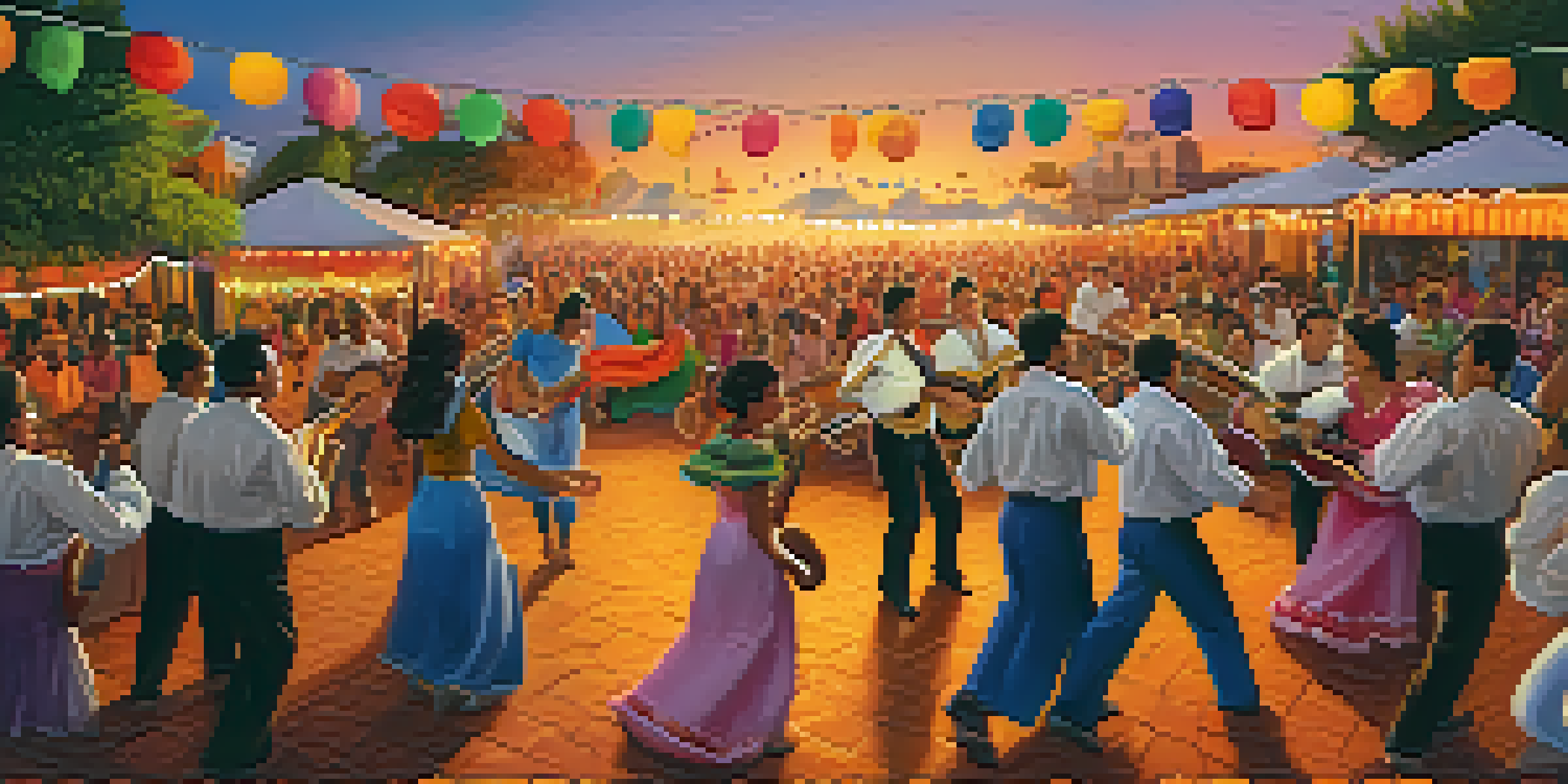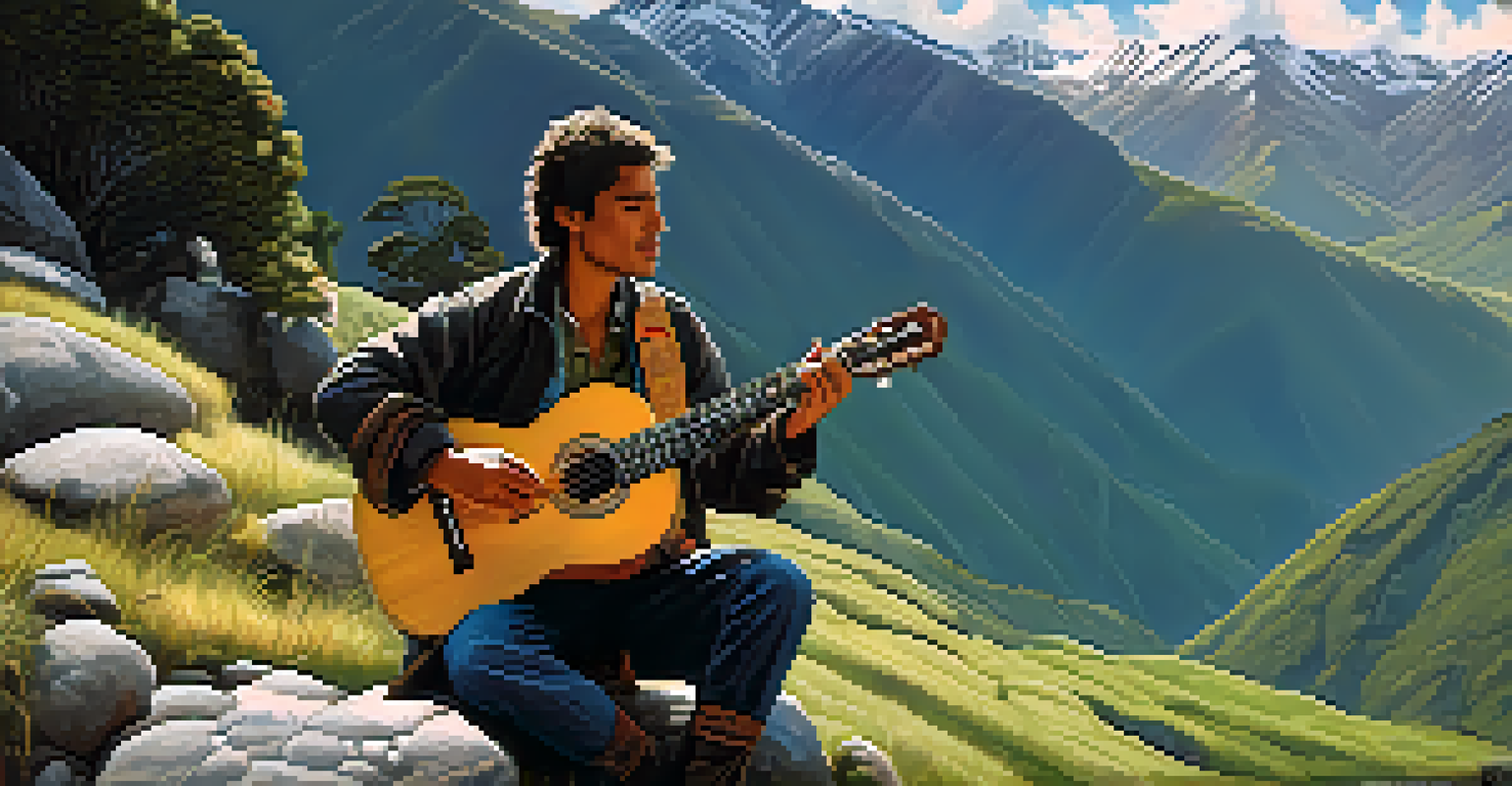Exploring the Role of Guitar in Latin American Folklore

The Historical Roots of the Guitar in Latin America
The guitar has a rich history in Latin America, tracing its roots back to the Spanish colonization. It was introduced by Spanish settlers and quickly became intertwined with local musical traditions. Over time, various indigenous and African influences merged with Spanish styles, creating a unique sound that reflects the region's diverse cultures.
The guitar is a bridge between cultures, a way to connect people through the universal language of music.
These early adaptations of the guitar laid the groundwork for different genres, such as Son, Bossa Nova, and Tango. Each region developed its distinctive style, incorporating local instruments and rhythms. This fusion of cultures is a beautiful testament to the guitar's ability to bridge gaps and connect people.
As a result, the guitar is more than just an instrument; it embodies the history and struggles of various communities. It has become a symbol of identity and resistance, showcasing the resilience of Latin American cultures through music.
The Guitar's Role in Traditional Folk Music
In traditional folk music, the guitar serves as a central accompaniment, providing rhythm and harmony. Whether in celebrations, religious rituals, or storytelling, its melodic lines help narrate tales of love, loss, and communal life. The strumming of the guitar often sets the tone for gatherings, inviting everyone to participate in the musical experience.

For instance, in Mexican folk music, the guitar complements instruments like the violin and trumpet, creating vibrant sounds that resonate with joy and nostalgia. Songs passed down through generations often feature intricate guitar riffs that are essential to their identity. This interdependence highlights how the guitar shapes the overall soundscape of Latin American folklore.
Guitar's Rich Cultural Heritage
The guitar in Latin America reflects a blend of indigenous, African, and Spanish influences, creating unique musical genres that embody the region's diverse cultures.
Moreover, these folk traditions are not just performances; they are gatherings of community, where the guitar brings people closer together. It acts as a conduit for shared emotions and collective memories, making each strum significant in the cultural tapestry.
Regional Variations and Their Unique Sounds
Latin America is a mosaic of cultures, and the guitar's role varies significantly across regions. In Brazil, the Bossa Nova style blends samba rhythms with jazz influences, producing a smooth, laid-back vibe. Meanwhile, in Argentina, the guitar is pivotal in Tango, where its passionate strumming evokes deep emotions and dramatic narratives.
Music is the shorthand of emotion, and the guitar translates that emotion into a narrative that speaks to the heart.
Each region has developed its distinctive technique and style, often reflecting the local environment and lifestyle. For example, in the Andean regions, the guitar is often paired with charangos, small stringed instruments made from armadillo shells, creating a unique sound that mirrors the mountainous landscapes. These variations showcase the guitar's adaptability and its capacity to resonate with different cultural contexts.
This diversity enriches the musical landscape of Latin America, making it a treasure trove of sounds and stories. The regional styles not only highlight the guitar's versatility but also celebrate the identity of the communities that embrace it.
The Guitar as a Storyteller in Folklore
In many Latin American cultures, the guitar is more than an instrument; it's a storyteller. Through its strings, it conveys the emotions and experiences of people, often narrating tales of struggle, love, and resilience. The melodies can evoke vivid imagery, drawing listeners into the heart of each story.
For instance, in the Chilean cueca, the guitar plays a crucial role in depicting themes of longing and nostalgia. The music often accompanies dance, allowing storytellers to express their narratives through movement as well. This interplay between guitar and dance enriches the storytelling experience, making it deeply engaging for the audience.
Role in Community and Identity
As a central element in traditional folk music, the guitar fosters community connections and serves as a storyteller, conveying emotions and shared experiences.
Thus, the guitar becomes a voice for those whose stories might otherwise go unheard. It captures the essence of life in Latin America, transforming personal experiences into collective memory through its captivating melodies.
The Influence of the Guitar on Contemporary Music
As Latin American music evolves, the guitar continues to play a vital role in contemporary genres. Artists blend traditional sounds with modern influences, creating innovative music that resonates with younger generations. This fusion often includes elements of pop, rock, and even electronic music, showcasing the guitar's versatility.
For example, artists like Juanes and Shakira incorporate the guitar into their pop songs, bridging the gap between folk roots and mainstream appeal. Their music often features catchy guitar riffs that enhance the emotional impact of their lyrics, making them relatable to a wider audience. This evolution demonstrates how the guitar can adapt while remaining true to its cultural origins.
Moreover, the rise of digital platforms has made these contemporary sounds more accessible, allowing traditional guitar music to reach a global audience. This exposure helps preserve Latin American folklore while simultaneously inviting new interpretations and collaborations across genres.
The Guitar in Festivals and Cultural Celebrations
Festivals are a vibrant part of Latin American culture, and the guitar is often at the center of these celebrations. Events like Carnival in Brazil or Día de los Muertos in Mexico feature lively music that brings communities together. The guitar’s infectious rhythms encourage participation, whether through dance or sing-alongs.
During these festivals, guitarists often showcase their skills, performing traditional songs that celebrate cultural heritage. The atmosphere is electric, with the guitar weaving through the crowd, inviting everyone to join in the joy. This communal experience highlights the guitar's ability to foster connections and create lasting memories.
Evolution in Contemporary Music
The guitar continues to shape modern Latin American music, blending traditional sounds with contemporary influences to resonate with new generations.
Additionally, these celebrations often serve as a platform for preserving traditions. Young musicians learn from seasoned players, ensuring the continuation of regional styles and techniques. In this way, the guitar not only entertains but also educates, passing down the rich cultural history of Latin America to future generations.
The Future of Guitar in Latin American Folklore
Looking ahead, the future of the guitar in Latin American folklore appears promising. With a new generation of musicians eager to explore and innovate, we can expect exciting developments in style and technique. This evolution will likely continue to honor traditional roots while incorporating global influences.
Moreover, the growing interest in world music has led to increased appreciation for Latin American guitar music. As more artists gain international recognition, the guitar's voice will resonate further, inspiring collaborations and new interpretations. This cross-pollination enriches the musical landscape and helps preserve the essence of folklore.

Ultimately, the guitar will remain a powerful emblem of identity and expression in Latin America. Its ability to adapt and evolve ensures that it will continue to play a vital role in shaping the region's musical narrative for years to come.